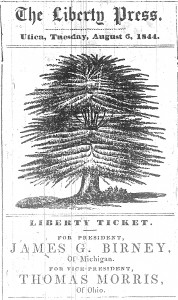Partisanship in the Antislavery Press during the 1844 Run of an Abolition Candidate for President
Volume 31, Issue 2, 2014
By Erika Pribanic-Smith
In Partisanship in the Antislavery Press during the 1844 Run of an Abolition Candidate for President, Erika Pribanic-Smith examined special interest newspapers focused on the cause of abolition to determine how those newspapers behaved during an election campaign that featured an abolitionist running as a third-party candidate against two slaveholders.
Historians have deemed this election important because the campaigning elevated tensions between those who supported slavery and those who opposed it as well as between the northern and southern contingents of the Whig and Democratic parties. Abolitionist James Birney played spoiler in this election; some argue that he siphoned antislavery votes from Whig Henry Clay in several northern states, most prominently New York, and contributed to the victory of Democrat James Polk. Polk was a proponent of annexation—the primary campaign issue. Some historians have declared that Polk’s election to office quickly resulted in the annexation of Texas, instigating the Mexican War and hastening the coming of the Civil War.
The era’s two-party political system extended into newspapers, which had held an important political function since the Revolutionary War. Although mercantile, penny, and special interest newspapers also existed in the 1840s, the partisan press still dominated, and its characteristics spilled over into other types of newspapers, including the abolitionist press. Partisan newspapers were distinguished by extreme bias and abusive language, disseminating propaganda through nationwide networks, promoting the respective parties’ ideologies and leaders, and disparaging opponents.
Pribanic-Smith argued that the abolitionist press behaved no differently during the 1844 election because of the animosity between factions of the antislavery movement. Birney had been a leader in the American Anti-Slavery Society when the organization fractured over differences of opinion that included whether abolitionists should be involved in politics. William Lloyd Garrison’s group used its newspapers to promote a non-voting agenda and attack Birney and his cohorts in the Liberty Party; Liberty newspapers extolled the virtues of their candidates and ideals while verbally assaulting the Garrisonians. Therefore, although abolitionist newspapers claimed to be focused solely on the eradication of slavery, their editors devoted numerous column inches to highly biased political discussion.
Teaching the Article: Exercises and Questions
Related readings:
Gregory A. Borchard, “The New York Tribune and the 1844 Election,” Journalism History 33, 1 (Spring 2007): 51-59.
Sheldon H. Harris, “John Louis O’Sullivan and the Election of 1844 in New York,” New York History 41, 3 (July 1960): 278-298.
Erika J. Pribanic-Smith, “Partisan News and the Third-Party Candidate: Press Coverage of James G. Birney’s 1844 Presidential Campaign.” Journalism History 39 (2013) 168-178.
Ford Risley, Abolition and the Press: The Moral Struggle Against Slavery (Evanston, Ill.: Northwestern University Press, 2008).
Si Sheppard, The Partisan Press: A History of Media Bias in the United States (Jefferson, N.C.: McFarland & Company, 2008).
